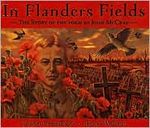Through the Looking Glass Children's Book Reviews
In Flanders Fields: The Story of the Poem by John McCrae
Illustrator: Janet Wilson
Nonfiction Picture Book
For ages 8 and up
Fitzhenry and Whiteside, 2005 ISBN: 978-1550051445
In Flanders in 1915 life "was HELL all the time" for both the soldiers and for the medical officers who did their best to take care of the troops when they were wounded. World War I was just a year old but it had taken a dreadful toll and John McCrae, a Canadian medical officer, was deeply moved by the terrible things he saw there. After one of his friends was killed by an enemy shell right in front of him John sat down and wrote a poem which would have a great impact on thousands of people around the world. The poem was not very long and it was called "In Flanders Fields." In the poem John pours out his pain and his loss, asking his readers not to forget the cause that so many soldiers died for and calling others to arms.
John McCrae came from a family with a tradition of serving both in the military and in the medical profession. He did both, serving in the Queen's Own Rifles while in university. He went to medical school and worked in hospitals in Canada and America, writing stories and poetry while he cared for the sick and taught.
John was in England on holiday when war was declared. He was willing to serve for Canada either as a soldier or a doctor but after a year in Flanders putting soldiers back together he had had more than enough - though he kept on doing what needed to be done. His poem was published in December of 1915 and it had an enormous impact, raising much needed funds and encouraging more young men to join the fight.
In this superb book the author not only tells the story of how "In Flanders Fields" came to be written, but she also tells her readers about the author of this marvelous poem, and she gives readers an excellent picture of what it was like to be a soldier or a medic in Flanders during World War I. Readers will get a vivid picture of what daily life on the front line must have been like in 1915, and the picture is very grim indeed. The author explains how Poppy Day came to be celebrated and what it signifies. Finally, the author and illustrator present the poem itself, with a backdrop of lovely paintings to set off the verse to best advantage.




